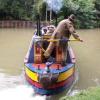Actually being really pedantic, I think it is based on 50% of the standard "list" price for CRT unsecure towpath moorings. If the nearest CRT online moorings were, for example, offside, and more secure, they would likely have a higher published price, and would not be used as a basis for working out the EOG rate.
When iI went into this in our area, though CRT had a recorded EOG rate for many of the local sites where it applies, and none were ever exactly 50% of the price for any local CRT towpath based moorings. Close, but never 50%, so however they work it out, it was never pick a site and half it, even though that is how they suggest itr is done, (unless they are just crap at arithmetic!).



